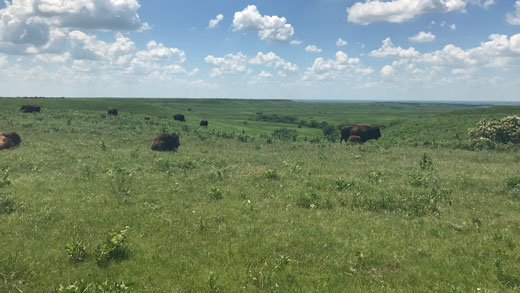Biology researcher receives NSF CAREER award to measure soil microbe, grazer interactions
Monday, March 30, 2020

Lydia Zeglin, a microbial ecologist, has received an NSF CAREER award to study interactions between prairie grazers and soil microbes. | Download this photo.
MANHATTAN — A Kansas State University researcher aims to understand the depth of nature's social circle.
Lydia Zeglin, microbial ecologist and assistant professor in the Division of Biology, was awarded nearly $650,000 from the National Science Foundation's Faculty Early Career Development Program to research interactions between the tallgrass prairie's largest species — bison and cattle — and the smallest — soil microbes.
"The College of Arts and Sciences is very proud of Dr. Zeglin not only for receiving this prestigious NSF CAREER award, but also for the societal and economic impact her work will bring to Flint Hills life and the Manhattan community," said Amit Chakrabarti, dean of the college.
The interactions between grazers and soil microbes are important for prairie biodiversity and may affect how soil can remediate nitrogen pollution.
"We know how important grasslands are for carbon storage, but intact prairie ecosystems are also sponges for nitrogen," Zeglin said. "This is in part because the soil microbes can pick up nitrogen quickly and help keep it in the soil for a long time, even after plant tissue has decomposed."
Plants need nitrogen — a building block of proteins, DNA and other essential molecules — for healthy growth, but plants can only use so much. According to Zeglin, if it wasn't for soil microbes, anything extra could leach out of the soil and pollute groundwater, streams, rivers and lakes.
"There may be a balance between the plant uptake and the microbial activity that regulates good plant growth versus potential for pollution," Zeglin said. "There's a concept called nitrogen retention, which is sort of the beneficial ecosystem service that we are interested in making sure we are measuring and sustaining."
Zeglin's preliminary research suggests that cattle and bison may provide a service to the ecosystem by helping microbes spread their good deeds around the prairie.
"Grasslands evolved with bison and other large animals," Zeglin said. "One intriguing consideration is that bison and cattle can move microbes around as they pass across the landscape. They also redistribute nitrogen as they move around, which might help cultivate certain types of soil bacteria and archaea. Our plan is to collect samples in a way that enables distinguishing between the two mechanisms."
Zeglin's research will test soil from multiple prairie locations with a citizen scientist approach.
"Our ultimate goal is to understand the nitrogen cycle in all prairie soils better," Zeglin said. "In order to do that, we need to interact with more people to get more coverage of different prairie soils. We will be working with The Nature Conservancy, ranchers and students to contribute soil samples from bison- and cattle-grazed areas across the Flint Hills to expand the range of understanding."
Zeglin and students, including graduate students in her fall Microbial Diversity class, will perform detailed investigations of soil microbial diversity and activity— some involving experimental manipulations — to learn whether soil chemistry determines microbial diversity, or vice versa. The results will be shared with high school science classes, undergraduate biology classes and private landowners, with an intent to expand the scope and dissemination of the science as broadly as possible.
